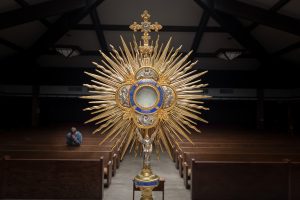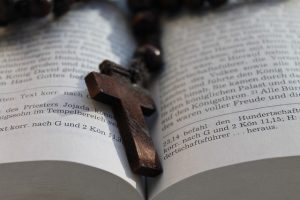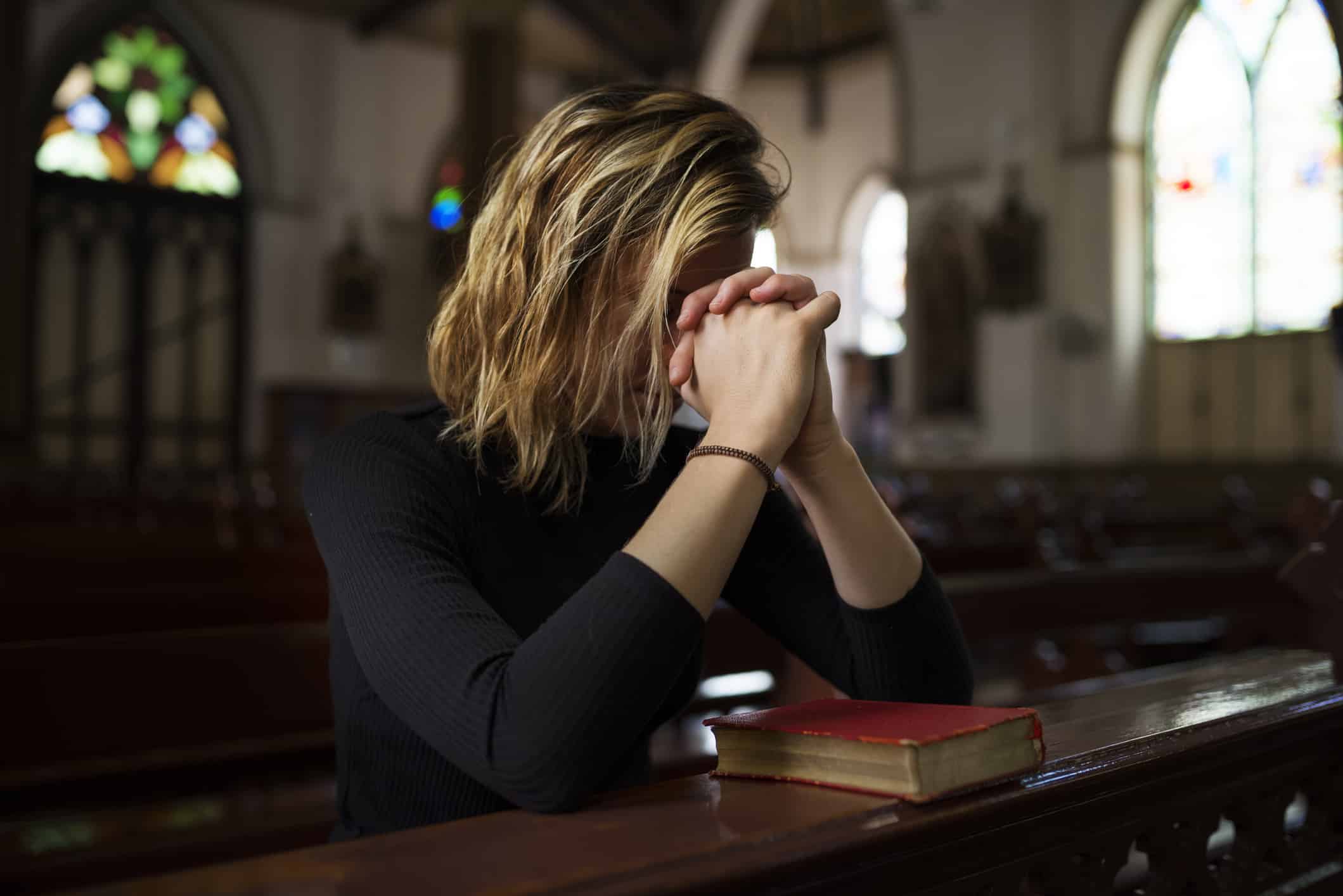Eucharistic Adoration
 The Saint George Church Adoration Chapel is open for private prayer daily, with an exposition of the Blessed Sacrament all day and night on Fridays. Eucharistic adoration takes place in the ‘Mothers’ Chapel’ from 9 am Friday after the school mass or 8 am (if there is no school) through Saturday at 8 am. Parishioners are encouraged to commit to an hour in the chapel during the exposition. This prayer ministry is vital in supporting the spiritual life of our parish.
The Saint George Church Adoration Chapel is open for private prayer daily, with an exposition of the Blessed Sacrament all day and night on Fridays. Eucharistic adoration takes place in the ‘Mothers’ Chapel’ from 9 am Friday after the school mass or 8 am (if there is no school) through Saturday at 8 am. Parishioners are encouraged to commit to an hour in the chapel during the exposition. This prayer ministry is vital in supporting the spiritual life of our parish.
Prayer Shawl Ministry
The Prayer Shawl ministry includes a group of women who knit and crochet shawls and small lap robes for anyone that could use a prayer shawl. They work at their own pace at home or gather twice monthly. The shawls are made with a continued prayer for those who receive this gift of love.
Hearts to God
At Saint George Church, the Hearts to God ministry calls to prayer for all parishioners and their special intentions as written in the parish book of prayers. They are dedicated to a joyful worship of God through the offering of various prayer events throughout the liturgical year.
“Blessed are the clean of heart,
for they will see God.”
(Matthew 5: 8)
Book of Intentions
Prayer requests can be made by calling the Rectory Office. You can ask for a name to placed in our Book of Intentions that is housed in the Church. We can also publish the name of a family member or friend if we receive permission from them or from a close relative.
Prayer List in Bulletin
Pray for healing:
- Marlene Bostick
- Jerry Kraus
- Tina Britt
- Elaine Hewett
- Richard Spadacene
- Cecilia Sabol
- Meghan Markiewicz
- Nancy Schill
To add a name to this prayer list to be printed in the bulletin, contact Gretchen Kerr by Email Here or call 814-864-0622. In order to add a name that will be printed in the bulletin, you must be either the person seeking prayers, on immediate relative and have the permission of the one to be held in prayer.
Mass Intentions and Sanctuary Candle
The Sanctuary Lamp is lit 24 hours a day, 7 days a week in honor of our living a deceased family and friends. The lamp is generally requested in memory or in honor of someone for one week (Monday-Sunday). To request the Sanctuary Lamp you can call the Rectory Office, stop by during regular business hours or mail in your request to Saint George Church 5145 Peach Street, Erie, PA 16509. You are also able to fill out an online form for your request. Suggested donation for the lamp is $10.00 and checks can be made payable to Saint George Church. Please include the following:
- Name(s) of the person(s) that are being remembered or honored. (Please include if the are living or deceased).
- Name(s) of who is requesting the Lamp and contact information (Phone, Email, address)
- Date of specific week in which you would like for it to be lit or first available. We will do our best to honor specific dates but at times may need to schedule as close as we can to the requested dates.
- A Rectory Office representative will confirm with you when you request has been confirmed.
To request a Mass for your friends and family please come by the parish office during office hours, fill out our online request form or send us your request by mail. Checks can be made payable to Saint George Church. When sending in a request, please mail to Saint George Church 5145 Peach Street Erie, PA 16509 and include:
- The Mass intention (if a single individual, please notate if they are living or deceased)
- If you’d like the first available Mass, or Mass offered on a particular date (the Mass intention book fills up quickly, and the first available Mass is usually six months out from the current date)
- Name
- Phone number
- Mass stipend (suggested donation is $10)
- The address where you would like the Mass card mailed.
Please note: Mass intentions cannot be accepted by the parish more than a full year from the current date of your request. A member of the parish staff will contact you to confirm your request!
Background on Mass Intentions
Whenever a priest celebrates Mass, he has at least two specific intentions. The first intention is to celebrate the Mass according to what the rubrics that the Church was provided for how to say the Mass. The second is to apply the grace of that Mass toward a specific need or intention. As to the first intention, a priest may find it helpful to pray a traditional prayer while he is vesting, stating his intention to pray the Mass well. As to the second intention, commonly called “the intention of the Mass,” that intention is often announced in the parish bulletin at least one week before, and then it is sometimes also announced at Mass.
These special intentions are offered to God as prayers of intercession and thanksgiving. In and through the Eucharist, we pray for the deceased, for those who are ill, for those who face various difficulties or challenges. Often, people request a Mass in thanksgiving for God’s grace helping them through a particularly challenging time of life. It is important to note that, while the graces of the Mass being infinite, many intentions can be offered up at a single Mass. While a priest may only accept one intention at a single Mass, he may have many other intentions not attached to an offering. In addition, the faithful may bring their own intentions to the Mass, which they each carry privately and place upon the altar spiritually in prayer.
Centering Prayer
Group members meet weekly on Monday evenings to pray and hold a yearly Fall retreat with visiting speakers and practitioners.
Christian Contemplative Prayer is the opening of mind and heart – our whole being – to God, the Ultimate Mystery, beyond thoughts, words, and emotions, whom we know by faith is within us, closer than breathing, thinking, feeling and choosing; even closer than consciousness itself. The root of all prayer is interior silence. Though we think of prayer as thoughts or feelings expressed in words, this is only one expression. Contemplative Prayer is a prayer of silence, an experience of God’s presence as the ground in which our being is rooted, the Source from whom our life emerges at every moment.
 For the Church’s first sixteen centuries Contemplative Prayer was the goal of Christian spirituality. After the Reformation, this living tradition was virtually lost. Today, with cross-cultural dialogue and historical research, the recovery of the Christian contemplative heritage has begun. The method of Centering Prayer, in the tradition of Lectio Divina (praying the scriptures), is contributing to this renewal.
For the Church’s first sixteen centuries Contemplative Prayer was the goal of Christian spirituality. After the Reformation, this living tradition was virtually lost. Today, with cross-cultural dialogue and historical research, the recovery of the Christian contemplative heritage has begun. The method of Centering Prayer, in the tradition of Lectio Divina (praying the scriptures), is contributing to this renewal.
Centering Prayer is a method of prayer, which prepares us to receive the gift of God’s presence, traditionally called contemplative prayer. It consists of responding to the Spirit of Christ by consenting to God’s presence and action within. It furthers the development of contemplative prayer by quieting our faculties to cooperate with the gift of God’s presence.
Centering Prayer facilitates the movement from more active modes of prayer – verbal, mental, or affective prayer – into a receptive prayer of resting in God. It emphasizes prayer as a personal relationship with God. At the same time, it is a discipline to foster and serve this relationship by a regular, daily practice of prayer. it is Trinitarian in its source, Christ-centered in its focus, and ecclesial in its effects; that is, it builds communities of faith.
Centering Prayer is drawn from ancient prayer practices of the Christian contemplative heritage, notably the Fathers and Mothers of the Desert, Lectio Divina, (praying the scriptures), The Cloud of Unknowing, St. John of the Cross and St. Teresa of Avila. It was distilled into a simple method of prayer in the 1970’s by three Trappist monks, Fr. William Meninger, Fr. Basil Pennington and Abbot Thomas Keating at the Trappist Abbey, St. Joseph’s Abbey in Spencer, Massachusetts.

